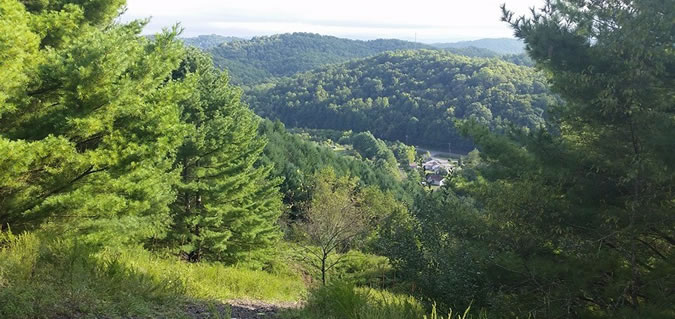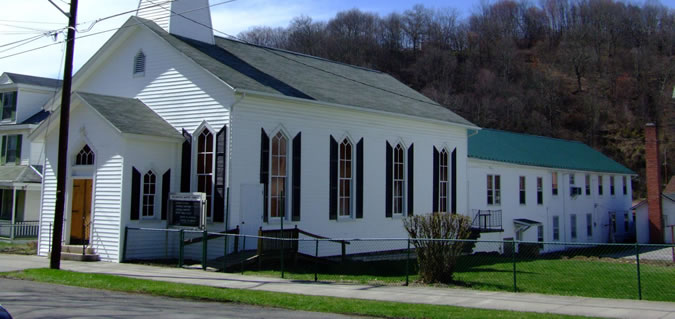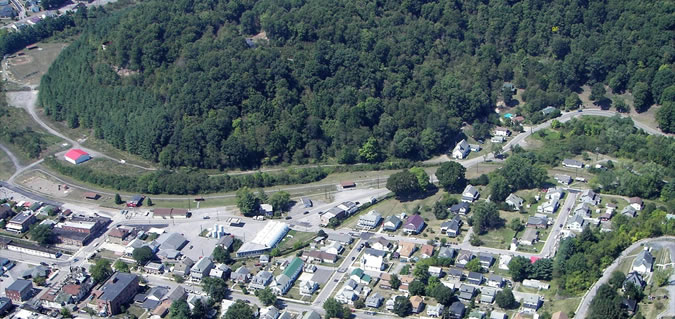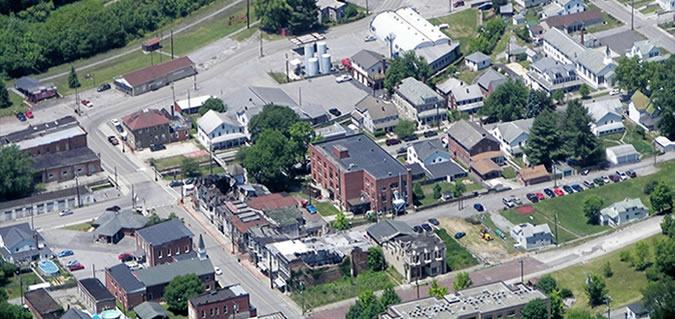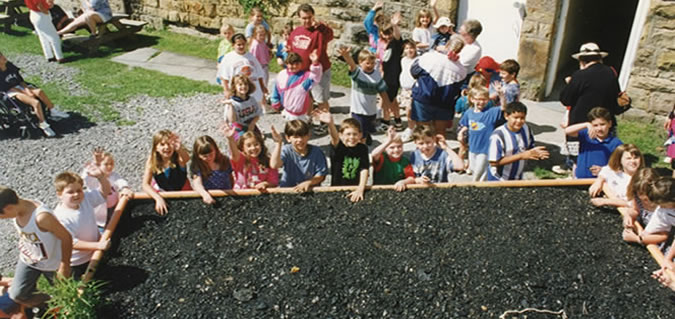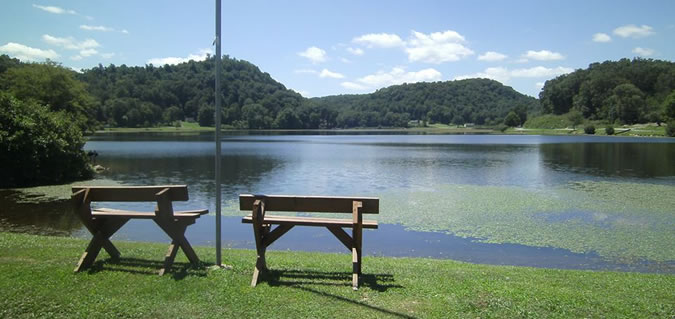Attractions
The Town of Pocahontas owns and operates the Pocahontas Exhibition Mine and Museum, a National Historic Landmark and Virginia’s official “coal heritage zone.” The “show mine,” as many locals call it, features tours from retired coal miners into the real mine that served as the birthplace of the world-famous Pocahontas #3 coal that heated homes across the United States and was the chosen fuel of the United States Navy. The exhibition mine, open from April-October annually, features a 13-foot tall coal seam. There is also a museum and education center located in the mine’s former powerhouse.
The town also features a registered Virginia Historic site, the Pocahontas Cemetery. The cemetery features graves that are over 100 years old and a mass grave of coal miners killed in a mine explosion in Pocahontas on March 13, 1884. Each year, the town holds a ceremony at the cemetery to remember the more than 114 coal miners killed in the explosion.
The town is also home to St. Elizabeth’s Roman Catholic Church which features ten life-sized murals on the ceiling and walls of the church. The church also holds an annual Hungarian cabbage roll dinner to honor the European heritage of the coalfields.
History of Pocahontas, VA and the Pocahontas Exhibition Mine and Museum
As early as 1860, Mr. Andrew Stowers, who lived near what is now known as the ‘old baseball ground’, just east of the Pocahontas Cemetery, operated a blacksmith shop and corn mill. Then No. 3 coal seam had been exposed where the Peeled Chestnut road crossed the outcrop, from which Mr. Stowers collected coal for his smithing operation. In 1867 or 1868 Mr. Jordan Nelson having his home in Boone County, West Virginia, decided to move farther out on the frontier. Mr. Nelson, hearing of Mr. Stower’s shop and mill, visited this section in 1866, and while here arranged to exchange his Boone County, West Virginia farm for the Stower’s property, thereby coming into possession of the shop, mill and 1000 acres of mountain land, which included all of the present town site of Pocahontas. In 1867 Mr. Nelson moved into his new home and continued to operate the industries established by Mr. Stowers. Mr. Nelson seems to have rapidly extended his business and within a very short time was serving customers from far away Bland County, the remote sections of Mercer and McDowell counties of West Virginia and Tazewell County, Virginia. In those days it was customary for every farmer, or at least someone in each neighborhood, to do the minor blacksmith work; knowing this Mr. Nelson immediately made use of this opportunity for increasing his revenue by advocating the use of coal in this new commercial venture, at first filling saddle bags with coal, later sacks of coal were carried to consumption points on horseback. Having an unusual mechanical mind Mr. Nelson made many improvements to his mill, finally conceiving the idea of heating his own home with fuel he had used so successfully in his blacksmith shop. After much thought he finally designed and, with his own hands, built a grate from old wagon tires and such other material as was available. This new and unsightly contraption replaced the irons in his fireplace, and forever removed from his cozy home the burning of sparkling logs, so long the practice in all frontier homes.
Mr. Nelson’s advertising brought customers from far and near for this mysterious fuel. One day a customer from far down on the Bluestone River arrived with an ox wagon, to haul a full wagon of coal. News of this unusual visitor rapidly spread over the neighborhood and finally reached the ears of ‘Aunt Betsy Thompson’ who owned a farm adjoining Mr. Nelson’s. Aunt Betsy alarmed and horrified rushed across the fields and down the hill to the mill where she announced in no unquestionable terms ‘This practice must be stopped.’ In her judgment, it was perfectly proper to supply small quantities for smithing purposes, but leaving there with wagon loads of the fuel the supply would soon become exhausted. To date more than 40,000,000 tons have been taken from this The Original Pocahontas Mine.
From 1863 to 1873 there was little accomplished in the way of development.
The country adjoining the actual mine openings, while as picturesque as any that could be found in a mountain region anywhere, was literally a jungle when the Southwest Virginia Improvement Company first broke ground for their development. The location for the Town of Pocahontas was then a strip of narrow, swampy valley, un-approached by any road or path and more than fifty miles distant from the nearest railroad, from which materials of every kind had to be hauled by wagon across two mountains and over almost impassable trails to the mines. Men came to the first permanent camp, known as Powell’s Bottom, mostly Hungarian, German and Welsh miners, on foot and by wagon from Hinton, West Virginia, and Wytheville, Virginia, the nearest railroad points.
The Town was named Pocahontas in 1881.
Under such adverse conditions development slowly advanced until in March 1883, the railroad reached Pocahontas and for many years Pocahontas was the western outpost of the Norfolk and Western Railway. The first carload of coal, loaded in Pocahontas, was used by the railroad. The second car of Pocahontas Coal was shipped on March 13th, 1883, consigned to Honorable William Lamb, Mayor of Norfolk, Virginia. It’s arrival in the city of Norfolk was the occasion of a great celebration. The railroad new line into Pocahontas was called the New River Division and was formally opened to traffic on May 21, 1883. From that time forward shipments of coal from Pocahontas increased rapidly and by the end of the year totaled 82,043 net tons. Since that time Original Pocahontas Coal has been shipped to every port in the world where coal is unloaded. The pioneers who settled the region met with many obstacles. The prospectors and first operators faced many difficulties; there were no wholesale houses or supply houses close by; the nearest bank was at Lynchburg, Virginia. Later in 1883, the first coke ovens were built, 200 in all. The early people suffered many hardships, there have been disasters, but the development has never stopped. Pocahontas had the first theater in this region, referred to as the Pocahontas Opera House. Many first run shows, operas, operettas and entertainers such as Weber and Fields included Pocahontas in their itinery. It is well know that special trains were run from Bluefield, West Virginia to Pocahontas, Virginia to enable Bluefielders to enjoy such performances. The Pocahontas Cemetery was the first organized burial ground in the Coal Fields. The Cemetery was the result of a history making mine explosion that tore through the East Mine of the Southwest Improvement Company, claiming the lives of some one-hundred and fourteen men and boys. The one hundred and fourteen miners were buried in the Pocahontas Cemetery side by side. Throughout the Cemetery history, victims of smaller mining explosions and accidents have been laid to rest along with others from Tazewell County, Mercer County, and McDowell County. Stone makers hewn in the native tongues of Hungarian, Italian, Russian, Polish, and Hebrew line the countless graves. These only further epitomize the uniqueness of the Pocahontas Cemetery for it was most unusual for people of different races and ethnic backgrounds to be buried together, especially in the South during the era that gave birth to the Cemetery. But is was fitting because here these people lived close together, worked together, died together and it was fitting that they be buried together.
The first churches followed people to Southwest Virginia. The Baptist and Methodist Churches were established in 1882, the Episcopal Church in 1884, the Roman Catholic Church in 1896, The Presbyterian Church in 1898, and the Hungarian Reform Church and the Jewish Synagogue after the turn of the century. As the churches were beginning to exert their influence, so to were over 20 saloons making their presence felt. Despite the rough and ready nature of Pocahontas on the weekends, the town carried on the business of education by opening a log cabin schoolhouse in 1884, operated by the Episcopalian Church. By 1900, the population had grown to around 3,200 and there were enough stores selling a variety of items that no one had to leave town to buy goods.
The Southwest Virginia Improvement Company built The Old Company Store in February of 1884. This was the first company store erected in the great Pocahontas Coal Fields. On the first level was the company store and on the upper levels were ample space for mining offices. Furniture and store equipment was installed and the building was occupied on the first of March. There were store clerks, salesmen, junior salesmen, milliner, dressmaker, janitor, porter, and teamsters. The company store provided a convenient place where coal mining families could purchase meat, groceries, clothing, furniture and mining supplies. The company store was the largest in town and was stocked with a large and fashionable line of general merchandise of good quality. The coal miner could obtain credit from the company store and pay his store bill, house rent, insurance, lights, water, smithing, coal, doctor, bath house, and miscellaneous bills through payroll deductions.
Pocahontas had the first theater in the region, referred to as the Pocahontas Opera House. Many first run shows, operas, operettas and entertainers such as Weber and Fields. Special trains ran from Bluefield West Virginia to Pocahontas so that Bluefielders could enjoy the performances at the Pocahontas Opera House. The Pocahontas Exhibition Mine and Museum is the site of the original Pocahontas ‘Baby’ Mine, which was the first coal mine opened in the Pocahontas Coal Fields. The Exhibition Mine was opened for tourist in 1938. It is the only exhibition coal mine in the world in which tourists may view the famed Pocahontas #3 Coal Seam, which is more than ten feet in height in it’s original state. The Pocahontas Exhibition Mine is the only exhibition mine recognized as a National Historic Landmark in the country. The Pocahontas Exhibition Mine and Museum is also recognized as Virginia’s Official Coal Heritage Zone.
The Pocahontas Exhibition Mine and Museum site is that of the Original Pocahontas Mine, which was the first mine opened in the Pocahontas Coal Field. The original mine was opened in 1883 and was worked out in October 1955. The Exhibition Mine was first opened to the public in 1938. It is the only Exhibition Coal Mine in the world in which visitors may view the famed Pocahontas #3 Coal Seam, which is more than ten feet in height, seen in its original state. The interior is well lite, and visitors will see how coal was cut, blasted down and loaded into mine cars. In contrast to modern methods of cutting the coal, there is an illustration of the old ‘hand’ method of undercutting, preliminary to blasting down the coal. The Pocahontas Exhibition Coal Mine is the only exhibition mine recognized as a National Historic Landmark in the country. The Pocahontas Exhibition Coal mine is also recognized as Virginia’s Official Coal Heritage Zone.
Adjacent to the Coal Mine is the Coal Heritage Museum (location of the original Power House), Gift Shop, and Educational Room.
- Designated as a National Historic Landmark
- Virginia’s official Coal Heritage Zone
- First Mine in the Pocahontas Coalfield
- Opened in 1882
- Spectacular 13 foot tall coal seam
- Mine operated for 73 years
- Produced more than 44 million tons of coal
- Coal produced would fill a train 6,000 miles long
- World famous Pocahontas Coal heated homes across America
- Chosen fuel of American Navy
Open May – October
- Tours of Mine and Golf cart tours available
- AAA Discounts available
- Group Tour Discounts Available/Night Group Tours Available min 20 per group
- Walking Tours of Historic Pocahontas — Advance Arrangements must be made.
- Restaurant at location
For more information call 276-945-2134 or 276-945-9522.
The ATV- Friendly town of Pocahontas was named for the Algonquian Indian woman Pocahontas. The town owns an operates the Pocahontas Exhibition Mine and Museum, a National Historic Landmark and Virginia’s official “coal heritage zone.” The “show mine” as many locals call it, features tours from retired coal miners into the real mine that served as the birthplace of the world-famous Pocahontas #3 coal that heated homes across the United States and was the chosen fuel of the United States Navy. The exhibition mine, open from April–August annually, features a 13-foot-tall coal seam. There is also a museum and education center located in the mine’s former powerhouse.

